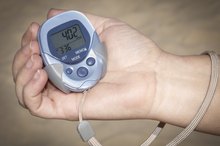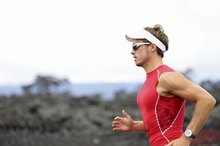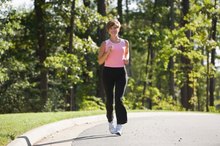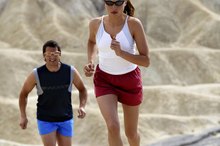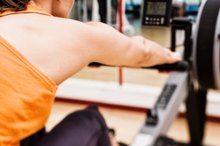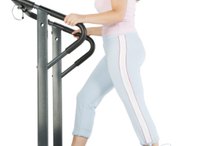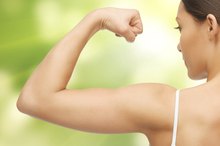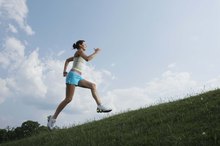With a consistent training program, running can be an effective method to lose weight. When you watch world-class distance runners, you will notice that all are thin. **Low body fat of elite sprinters allows their muscle definition to be seen.
** While you may not aspire to be a competitive athlete, you can lose weight by running. Several factors will determine how much weight you lose.
Calories
To lose weight, more calories must be expended than consumed. How many calories you need to maintain your weight depends on your muscle mass and activity. Increasing your activity will burn more calories. **A pound is equivalent to 3,500 calories.
** For instance, if you run 4 miles five times a week, expending 350 calories each time, you will lose 1/2 lb. per week, resulting in the loss of 1,750 calories in a week.
- To lose weight, more calories must be expended than consumed.
- per week, resulting in the loss of 1,750 calories in a week.
Diet
How to Run Using Jeff Galloway's Run/Walk/Run Training Method
Learn More
When you start a regular exercise program, you may also change your diet.
If you are eating 1,800 calories daily and also burning 2,300 calories each day, you are using 500 calories more than you are eating each day. In seven days, you will have expended 3,500 more calories than you consumed, which means you will lose a pound a week. This only works as long as you are eating a balanced diet. If you are eating too few calories, your body goes into starvation mode, slowing down metabolism so fewer calories are used.
- When you start a regular exercise program, you may also change your diet.
- If you are eating too few calories, your body goes into starvation mode, slowing down metabolism so fewer calories are used.
Weight
When you are walking, one foot is always on the ground. Running involves lifting the body off the ground with every step. The amount of work in running increases with body weight.
Using the calculator on the Fitness website, running 4 miles in 40 minutes burns 306 calories if you weigh 100 lbs., while a 200-lb. runner burns 612, which is twice the calories.
- When you are walking, one foot is always on the ground.
Pace
How to Determine Walking Speed
Learn More
Just like a car uses more gas to go at higher speeds, so do humans. Running 4 miles in an hour is 4 mph. Runners omit the term “per mile” and refer this as a 15-minute pace, which is written as 15:00.
A 4-mile time of 30 minutes is a 7:30 pace or 8 mph. Fast runners at a 5:00 pace are going to finish 4 miles in 20 minutes.
The calculator at FitnessMagazine shows there is a 138-calorie difference between a 150-lb. runner doing 20 minutes at a fast 6:00 pace, which amounts to 367 calories, compared with the same person running for 20 minutes at 10:00 pace using 229 calories.
Running faster means that one exercises for less time. When effort and time are combined, there is not much difference in calories consumed by running 4 miles. There is only an 18-calorie difference between finishing the mile in 40 minutes or 24 minutes. A 150-lb.
runner covering 4 miles in 40 minutes, a 10:00 pace, uses 459 calories. The same runner would expend 441 calories to finish in 24 minutes at a 6:00 pace.
- Just like a car uses more gas to go at higher speeds, so do humans.
- When effort and time are combined, there is not much difference in calories consumed by running 4 miles.
Terrain
Mountain trail running in Colorado or other high elevation requires more calories than running on a track at sea level for several reasons. **Running on an uneven surface, slippery surface or on sand requires more effort and uses more calories.
** Moving your weight against gravity by running uphill or up sets of stairs burns more calories than running on a flat surface. Training at high altitude where there is less oxygen also raises the number of calories used.
- Mountain trail running in Colorado or other high elevation requires more calories than running on a track at sea level for several reasons.
Running Fitness and Form
As you get fit, you will notice that it takes less effort to do the same run at the same time 1. Your stride may become smoother. You are using fewer calories to run. Aerobic fitness can be measured by variables such as VO2 and lactate threshold that show how your body metabolism uses oxygen during exercise. Gina Kolata in The New York Times explains that there is not a specific running form that is most efficient 1.
An estimate of calories used during a run can be made from pace, terrain and your weight.
Even a top running coach observing how you run cannot tell exactly how many calories that you burn. Calculating calories used in a run is not an exact science.
- As you get fit, you will notice that it takes less effort to do the same run at the same time 1.
- Even a top running coach observing how you run cannot tell exactly how many calories that you burn.
Related Articles
References
- “The New York Times”; Runing Efficiency: It’s Good, but How Do You Get It?
- Calorie Burners: Activities that turn up the heat. American Council on Exercise
- Li SSW, Chan OHT, Ng TY, et al. Gender Differences in Energy Expenditure During Walking With Backpack and Double-Pack Loads. Hum Factors. 2018;:18720818799190. doi:10.1177/0018720818799190
- Chang CH, Lin KC, Ho CS, Huang CC. Accuracy of the energy expenditure during uphill exercise measured by the Waist-worn ActiGraph. J Exerc Sci Fit. 2019;17(2):62-66. doi:10.1016/j.jesf.2019.01.003
- Champagne CM, Broyles ST, Moran LD, et al. Dietary intakes associated with successful weight loss and maintenance during the Weight Loss Maintenance trial. J Am Diet Assoc. 2011;111(12):1826-35. doi:10.1016/j.jada.2011.09.014
- LAYDEN, J. D., PATTERSON, M. J., & NIMMO, M. A. (2002). Effects of reduced ambient temperature on fat utilization during submaximal exercise. Medicine & Science in Sports & Exercise, 34(5), 774–779. doi:10.1097/00005768-200205000-00008
- Li, S. S. W., Chan, O. H. T., Ng, T. Y., Kam, L. H., Ng, C. Y., Chung, W. C., & Chow, D. H. K. (2018). Gender Differences in Energy Expenditure During Walking With Backpack and Double-Pack Loads. Human Factors: The Journal of the Human Factors and Ergonomics Society, 61(2), 203–213. doi:10.1177/0018720818799190
- Michael N. Sawka,1 C. Bruce Wenger, Andrew J. Young, and Kent B. Pandolf. Physiological Responses to Exercise in the Heat. Copyright 1993 by the National Academy of Sciences. All rights reserved.
- Morio, B., Beaufrere, B., Montaurier, C., Verdier, E., Ritz, P., Fellmann, N., … Vermorel, M. (1997). Gender differences in energy expended during activities and in daily energy expenditure of elderly people. American Journal of Physiology-Endocrinology and Metabolism, 273(2), E321–E327. doi:10.1152/ajpendo.1997.273.2.e321
- Yue, A. S. Y., Woo, J., Ip, K. W. M., Sum, C. M. W., Kwok, T., & Hui, S. S. C. (2007). Effect of age and gender on energy expenditure in common activities of daily living in a Chinese population. Disability and Rehabilitation, 29(2), 91–96. doi:10.1080/09638280600662232
- Ainsworth, B.; Haskell, W.; Herrmann, S. et al. Compendium of Physical Activities: A Second Update of Codes and MET Values. Med Sci Sports Exercise. 2011;43:1575. DOI: 10.1249/MSS.0b013e31821ece12.
- American Council on Exercise. (2009) Fit Facts - Calories Burners: Activities That Turn Up the Heat. San Diego, California: American Council on Exercise.
Writer Bio
Jennifer Williams has been writing as a freelancer for local newspapers since 1999. Her work now appears on various websites. She did a five-year orthopaedic surgery residency, followed by a one-year sports medicine fellowship and has been a team physician for NCAA Division I universities and high school teams. As a former collegiate athlete, Williams continues competition at the masters level.

